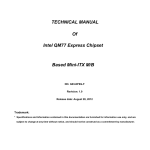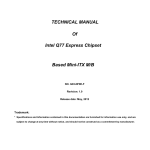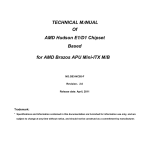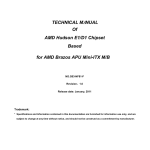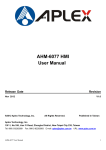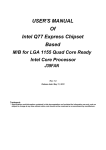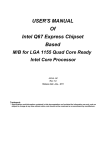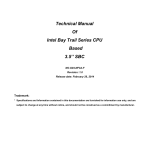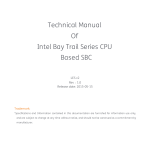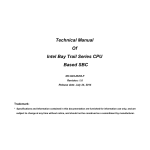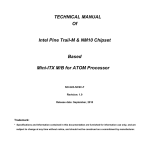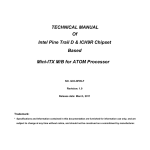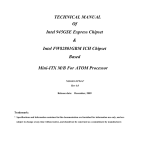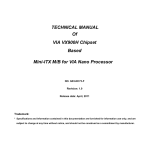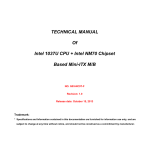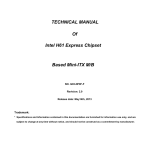Download TECHNICAL MANUAL Of AMD Hudson M1
Transcript
TECHNICAL MANUAL Of AMD Hudson M1 Chipset Based for AMD G-Series APU Mini-ITX M/B NO.G03-NF35-F Revision: 2.0 Release date: March, 2012 Trademark: * Specifications and Information contained in this documentation are furnished for information use only, and are subject to change at any time without notice, and should not be construed as a commitment by manufacturer. Environmental Protection Announcement Do not dispose this electronic device into the trash while discarding. To minimize pollution and ensure environment protection of mother earth, please recycle. ii TABLE OF CONTENT ENVIRONMENTAL SAFETY INSTRUCTION........................................................................... iv USER’S NOTICE ....................................................................................................................... v MANUAL REVISION INFORMATION ....................................................................................... v ITEM CHECKLIST ..................................................................................................................... v CHAPTER 1 INTRODUCTION OF THE MOTHERBOARD 1-1 FEATURE OF MOTHERBOARD................................................................................ 1 1-2 SPECIFICATION ......................................................................................................... 2 1-3 LAYOUT DIAGRAM.................................................................................................... 3 CHAPTER 2 HARDWARE INSTALLATION 2-1 JUMPER SETTING ..................................................................................................... 7 2-2 CONNECTORS AND HEADERS................................................................................ 9 2-2-1 CONNECTORS ............................................................................................. 9 2-2-2 HEADERS ..................................................................................................... 10 CHAPTER 3 INTRODUCING BIOS 3-1 ENTERING SETUP ..................................................................................................... 15 3-2 BIOS MENU SCREEN ................................................................................................ 16 3-3 FUNCTION KEYS ....................................................................................................... 17 3-4 GETTING HELP .......................................................................................................... 17 3-5 MANU BAR ................................................................................................................. 18 3-6 MAIN MENU ................................................................................................................ 18 3-7 ADVANCED MENU..................................................................................................... 20 3-8 CHIPSET MENU.......................................................................................................... 25 3-9 BOOT MENU ............................................................................................................... 27 3-10 SECURITY MENU ....................................................................................................... 28 3-11 SAVE & EXIT MENU................................................................................................... 29 iii Environmental Safety Instruction z Avoid the dusty, humidity and temperature extremes. Do not place the product in any area where it may become wet. z 0 to 60 centigrade is the suitable temperature. (The figure comes from the request of the main chipset) z Generally speaking, dramatic changes in temperature may lead to contact malfunction and crackles due to constant thermal expansion and contraction from the welding spots’ that connect components and PCB. Computer should go through an adaptive phase before it boots when it is moved from a cold environment to a warmer one to avoid condensation phenomenon. These water drops attached on PCB or the surface of the components can bring about phenomena as minor as computer instability resulted from corrosion and oxidation from components and PCB or as major as short circuit that can burn the components. Suggest starting the computer until the temperature goes up. z The increasing temperature of the capacitor may decrease the life of computer. Using the close case may decrease the life of other device because the higher temperature in the inner of the case. z Attention to the heat sink when you over-clocking. The higher temperature may decrease the life of the device and burned the capacitor. iv USER’S NOTICE COPYRIGHT OF THIS MANUAL BELONGS TO THE MANUFACTURER. NO PART OF THIS MANUAL, INCLUDING THE PRODUCTS AND SOFTWARE DESCRIBED IN IT MAY BE REPRODUCED, TRANSMITTED OR TRANSLATED INTO ANY LANGUAGE IN ANY FORM OR BY ANY MEANS WITHOUT WRITTEN PERMISSION OF THE MANUFACTURER. THIS MANUAL CONTAINS ALL INFORMATION REQUIRED TO USE THIS MOTHER-BOARD SERIES AND WE DO ASSURE THIS MANUAL MEETS USER’S REQUIREMENT BUT WILL CHANGE, CORRECT ANY TIME WITHOUT NOTICE. MANUFACTURER PROVIDES THIS MANUAL “AS IS” WITHOUT WARRANTY OF ANY KIND, AND WILL NOT BE LIABLE FOR ANY INDIRECT, SPECIAL, INCIDENTIAL OR CONSEQUENTIAL DAMAGES (INCLUDING DAMANGES FOR LOSS OF PROFIT, LOSS OF BUSINESS, LOSS OF USE OF DATA, INTERRUPTION OF BUSINESS AND THE LIKE). PRODUCTS AND CORPORATE NAMES APPEARING IN THIS MANUAL MAY OR MAY NOT BE REGISTERED TRADEMARKS OR COPYRIGHTS OF THEIR RESPECTIVE COMPANIES, AND THEY ARE USED ONLY FOR IDENTIFICATION OR EXPLANATION AND TO THE OWNER’S BENEFIT, WITHOUT INTENT TO INFRINGE. Manual Revision Information Reversion 2.0 Revision History Second Edition Date March 2, 2012 Item Checklist 5 5 5 5 5 Motherboard User’s Manual CD for motherboard utilities DVI-VGA Converter Cable(s) v Chapter 1 Introduction of the Motherboard 1-1 Feature of motherboard AMD G-Series APU + Hudson M1 Chipset Onboard AMD eOntario (G-Series) Dual core APU, with low power consumption never denies high performance. Support DirectX 11 3D Graphics Acceleration Support 2 * Serial ATA3 (6Gb/s) Devices Support 64-bit SODIMM DDRIII 800/1066 Single Channel, up to 8GB Support CF card Onboard REALTEK RTL 8111EVL Gigabit Ethernet LAN chip. Integrated REALTEK ALC 662-GR 4-channel HD audio CODEC Support USB 2.0 data transport demands. Support RS232/422/485 and watchdog. Support CPU Smart FAN Compliance with ErP standard 1 1-2 Specification Spec Design Chipset Embedded CPU Description z z z z Memory Slot Expansion Slots z z z z z Integrate IDE LAN HD Audio BIOS Multi I/O z z z z z z z z z z z z 3.5”SBC 6 layers; PCB size: 14.8x 10.2 cm Hudson M1 Chipset Support AMD eOntario (G-Series) Dual core T56N 1.6GHz / T40E 1.0GHz APU 1 * 200-pin DDRIII SODIMM Slot for un-buffered Single Channel 64-bit DDRIII 800/1066 SDRAM Expandable to 8GB CF card slot x1 Mini-PCI E slot x1 (Optional) Mini-SATAIII slot x1(alternative with Mini PCI-E) One PCI IDE controller that supports PCI Bus Mastering, ATA PIO/DMA and the ULTRA DMA /100/66 functions that deliver the data transfer rate up to 100MB/s. Integrated Realtek RTL8111EVL PCI-E Gigabit LAN. Support Fast Ethernet LAN function of providing 10/100/1000Mbps Ethernet data transfer rate Realtek ALC662-GR 4-channel HD Audio Codec integrated Audio driver and utility included AMI 16MB Flash ROM DVI-I connector x1 USB 2.0 port x 4 and USB 2.0 header x2 RJ-45 gigabit LAN connector x2 Audio Line out connector x1 SATAIII connector x2 Front panel header x1 RS422/485 header x2 2 z z z 1-3 LVDS connector x1 GPIO connector x1 SYSTEM FAN header x1 Layout Diagram RJ-45 LAN Connectors DVI-I Connector DC12V Power Connector Line-Out Connector USB 2.0 Connectors USB 2.0 Connectors 3 USB 2.0 Audio Headers Line-out RJ-45 LAN Ports DVI-I Connector USB 2.0 Headers DC 12V Power Connector Front Panel Audio Header JP2 USB 2.0 Headers LVDS Inverter LVDS Header Mini PCIE slot/ Mini SATA slot Serial port Headers JP1 Serial port Headers GPIO Header SATA III 6Gb/s Connectors SO-DIMM Slot JBAT SATA DISK Power Connector CIR Header JP3 JCOM1 Front Panel Header CF Card Slot SYSFAN Header TX-RX COM1 Header JCOMP1 4 Reset Power on AMD eOntario (G-Series) Dual core T56N 1.6GHz/T40E 1.0GHz APU Hudson M1 Chipset Jumper Jumper JBAT JCOM1 JCOMP1 JP1 JP2 JP3 Name CMOS RAM Clear Function Setting COM1 RS232/422/485 Function Select COM1 RS232 Power Select Inverter VCC 12V/5V Select LVDS 5V/3.3V Select CF Card Master/Slave Mode Select 5 Description 3-pin Block 6-pin Block 6-pin Block 3-pin Block 3-pin Block 3-pin Block Connectors Connector DC12V_IN CN1/CN3 DVI1 LAN1/LAN2 HOUT1 SATA1/DATA2 PWOUT1 Name DC Power Connector USB Port Connectors DVI Port Connector RJ-45 LAN Connector Line Out Connector Serial ATAII Connector Power Out Connector Description 1-phone Jack 4-pin Connectors 24-pin Connector 8-pin Connector 1-phone Jack 7-pin Connector 4-pin Connector Headers Header AUDIO1 COM1/COM2/ COM3/COM4 TX-RXCOM1 USB1/USB2 JW_FP1 CIR GPIO1 SYSFAN1 INVERTER1 LVDS1 Name Front Panel Audio Header Serial port headers Description 9-pin block 9-pin block RS422/485 header 4-pin block USB header 9-pin block Front Panel Header 8-pin Block (PWR LED/ HD LED/ /Power Button /Reset) CIR header 4-pin block GPIO header 10-pin block FAN Speed Headers 3-pin Block LVDS Inverter Connector 7-pin Block LVDS Connector 36-pin Block 6 Chapter 2 Hardware Installation 2-1 Jumper Setting (1) JBAT(3-pin): Clear CMOS JBAT JBAT 1 1 3 1-2 closed: Normal (2) 3 2-3 closed : Clear CMOS JCOM1(6-pin): COM1 Port RS232/422/485 function select JCOM1 1 1-2 closed: RS232 7 1 3-4 closed : RS485 1 5-6 closed : RS422 (3) JCOMP1(6-pin): COM1 PRS232 power select JCOMP1 1 (4) 3-4 closed : +12V 5-6 closed :+5V JP1 (3-pin): Inverter VCC 5V/12V select JP1 JP1 1 1 3 1-2 closed: Inverter 12V Select (5) 1 1 1-2 closed: RS232 3 2-3 closed : Inverter 5V Select JP2 (3-pin): LVDS 5V/3.3V select JP2 JP2 1 3 1-2 closed: LVDS VCC 5V 8 1 3 2-3 closed : LVDS VCC 3.3V (6) JP3(3-pin): CF card Master /Slave Mode setting JP3 JP3 1 1 3 1-2 closed: CF Card Slave Mode 3 2-3 closed :CF card Master Mode 2-2 Connectors and Headers 2-2-1 Connectors (1) Rear Panel Connectors DVI-I Connector RJ-45 LAN Connectors DC12V Power Connector Line-Out Connector USB 2.0 Connectors USB 2.0 Connectors (2) Serial-ATA Port connector: SATA1/SATA2 These SATAIII connectors support SATA 6Gb/s specification. Please connect SATAIII device to the connector with SATAIII cable. One connector supports one SATA device. 9 Pin No. Definition 1 GND 2 TXP 3 4 TXN GND 5 RXN 6 RXP 7 GND 2-2-2 Headers LINE1-L GND AUDIO NC LINE1-R KEY (1) Front panel audio (9-pin): AUDIO1 2 10 Pin 1 SENSE LINTOUT-L LINEOUT-R MIC1-R MIC2-L 9 Line-Out, MIC Headers -DSR -RTS -CTS RI NC -DCD SOUT -DTR GND Serial Port Connectors (9-pin): COM1/COM2/COM3/COM4 Pin1 -SIN (2) Serial Port 9-pin Block 10 TXDN RXDN (3)TX-RXCOM Header (4-pin): TX-RXCOM1 Pin 2 TXDP RXDP Pin 1 TX-RXCOM1 Header VCC -DATA +DATA GND NC (4)USB Port Headers (9-pin): USB1/USB2 VCC - DATA +DATA GND Pin 1 USB Port Header PWRBTN G ND GND PWRBTN PWRLE D HDDLE JW FP1 RS TS W V CC5 PWR LED (5)Front Panel Header (8-pin): JW_FP1 11 RESET HDLED V CC5 Pin 1 GND CIR LED 5VSB CIR_RX (6) CIR Header (4-pin): CIR 1 4 CIR Header GND GP36 GP34 GP32 GP3O (7) GPIO Header (10-pin): GPIO1 Pin 1 VCC5 GP37 GP35 GP33 GP31 2 GPIO Header (8) SYSFAN Header (3-pin): SYSFAN1 DET VCC12V GND 3 1 Fan Header 12 (9) LVDS Inverter (7-pin): INVERTER1 Pin 1 INVERTER Pin No. Definition 1 VCC 2 VCC 3 4 GND GND 5 Backlight 6 GND 7 Brightness (10)LVDS Header (36-pin): LVDS1 Pin 2 Pin 1 LVDS Header 13 Pin NO. Pin 1 Pin Definition LVDSB_DATAN3 Pin NO. Pin Definition Pin 3 Pin 5 Pin 7 Pin 9 Pin 11 Pin 13 Pin 15 Pin 17 Pin 19 LVDSB_CLKBN LVDSB_DATAN2 LVDSB_DATAN1 LVDSB_DATAN0 LVDS_DDC_DATA GND GND LVDSA_DATAP3 LVDS_CLKAP Pin 2 Pin 4 Pin 6 Pin 8 Pin 10 Pin 12 Pin 14 Pin 16 Pin 18 Pin 20 LVDSB_DATAP3 LVDSB_DATABP LVDSB_DATAP2 LVDSB_DATAP1 LVDSB_DATAP0 LVDS_DDC_CLK GND GND LVDSA_DATAN3 Pin 21 LVDSA_DATAP2 Pin 22 LVDSA_DATAN2 Pin 23 LVDSA_DATAP1 Pin 24 LVDSA_DATAN1 Pin 25 LVDSA_DATAP0 Pin 26 LVDSA_DATAN0 PVDD Pin 28 PVDD Pin 29 PVDD Pin 30 PVDD Pin 31 GND Pin 32 GND Pin 33 +5V Pin 34 N/A Pin 35 +12V (Reserved) Pin 36 +3V Pin 27 14 LVDS_CLKAN Chapter 3 Introducing BIOS Notice! The BIOS options in this manual are for reference only. Different configurations may lead to difference in BIOS screen and BIOS screens in manuals are usually the first BIOS version when the board is released and may be different from your purchased motherboard. Users are welcome to download the latest BIOS version form our official website. The BIOS is a program located on a Flash Memory on the motherboard. This program is a bridge between motherboard and operating system. When you start the computer, the BIOS program will gain control. The BIOS first operates an auto-diagnostic test called POST (power on self test) for all the necessary hardware, it detects the entire hardware device and configures the parameters of the hardware synchronization. Only when these tasks are completed done it gives up control of the computer to operating system (OS). Since the BIOS is the only channel for hardware and software to communicate, it is the key factor for system stability, and in ensuring that your system performance as its best. 3-1 Entering Setup Power on the computer and by pressing <Del> immediately allows you to enter Setup. If the message disappears before your respond and you still wish to enter Setup, restart the system to try again by turning it OFF then ON or pressing the “RESET” button on the system case. You may also restart by simultaneously pressing <Ctrl>, <Alt> and <Delete> keys. If you do not press the keys at the correct time and the system does not boot, an error message will be displayed and you will again be asked to Press <Del> to enter Setup 15 3-2 BIOS Menu Screen The following diagram show a general BIOS menu screen: Menu Bar General Help Items Menu Items Current Setting Value Function Keys BIOS Menu Screen 16 3-3 Function Key In the above BIOS Setup main menu, you can see several options. We will explain these options step by step in the following pages of this chapter, but let us first see a short description of the function keys you may use here: z Press←→ (left, right) to select screen; z Press ↑↓ (up, down) to choose the item you want to confirm or to modify in the main menu. z Press <Enter> to select. z Press <+>/<–> key when you want to modify the BIOS parameters for the active option. z [F1]: Press to general help information. z [F2]: Press to load previous value. z [F3]: Press to load optimized defaults. z [F4]: Save and Exit. z Press <Esc> to quit the BIOS Setup. 3-4 Getting Help Main Menu The on-line description of the highlighted setup function is displayed at the top right corner the screen. Status Page Setup Menu/Option Page Setup Menu Press [F1] to pop up a small help window that describes the appropriate keys to use and the possible selections for the highlighted item. To exit the Help Window, press <Esc>. 17 3-5 Menu Bar There are six menu bars on top of BIOS screen: Main Advanced Chipset Boot Security Save & Exit To change system basic configuration To change system advanced configuration To change chipset configuration To change boot settings Password settings Save setting, loading and exit options. User can press the ←/→ (left, right) arrow key on the keyboard to switch from menu bar. The selected one is highlighted. 3-6 Main Menu Main menu screen includes some basic system information. Highlight the item and then use the <+> / <-> key or numerical keyboard keys to select the value you want in each item. 18 System Date Set the date. Please use [TAB]to switch between data elements. System Time Set the time. Please use[TAB] to switch between time elements. 19 3-7 Advanced Menu Onboard Lan 1/Onboard Lan 2 Use the above items to enable or disable onboard LAN 1/2. Onboard Lan BootROM Use this item to enable or disable boot option for legacy network devices. Wake Up By Pcie(WOL) Use this item to enable or disable system to wake up by PCIE LAN (WOL) function. ► ACPI Settings 20 Enable ACPI Auto Configuration Use this item to enable or disable BIOS ACPI auto configuration. Enable Hibernation Use this item to enable or disable system ability to hibernate (OS/S4 Sleep State). This option may be not effective with some OS. ACPI Sleep State Use this item to select the highest ACPI sleep state the system will enter when the suspend button is pressed. The optional settings are: [Suspend Disabled]; S3 (Suspend to RAM). ► S5 RTC Wake Settings This item will enable system to wake up from S5 using RTC alarm. Press [Enter] to go into sub-item: Wake System with Fixed Time. The optional settings are: [Enabled]; [Disabled]. When set as Enabled, system will wake on the hour/minute/second specified. Please follow onscreen instructions. ► CPU Configuration PSTATE Adjustment This item is provided to adjust startup P-state level. PPC Adjustment This item is provided to adjust _PPC object. SVM Mode Use this item to enable or disable CPU SVM virtualization. The optional settings are: [Disabled]; [Enabled]. 21 C6 Mode The optional settings are: [Disabled]; [Enabled]. ► SATA Configuration Press [Enter] to make specified settings for available SATA device. ► Super IO Configuration ► Serial Port 1 Configuration Press [Enter] and set parameter of the following sub-items for serial port1: Serial Port Use this item to enable or disable serial port (COM). Change Settings Use this item to select an optimal setting for super IO device. RS232 or RS 485 Select Use this item to select RS 232 or RS 485 for serial port. ► Serial Port 2 Configuration Press [Enter] and set parameter of the following sub-items for serial port2: Serial Port Use this item to enable or disable serial port (COM). Change Settings Use this item to select an optimal setting for super IO device. Device Mode The optional settings are: [Standard Serial Port Mode]; [IrDA function, active pulse is 1.6 us]; [IrDA function, active pulse is 3/16 bit time]. ERP Support Use this item to enable or disable ERP function. 22 Power on after Power Fail The optional settings are: [Former-Sts]; [Power On]; [Power Off]. WatchDog Function Use this item to enable or disable Watchdog Timer Control. When set as Enabled, the following sub-items shall appear: WatchDog Timer Unit The optional settings are: [Sec];[Min]. WatchDog Timer Value User can set a value in the range of 5 to 255. ► H/W Monitor Press [Enter] to view hardware health status. User can also make settings to the smart fan mode. SYSFAN1 Smart Mode When set as [Enabled], the following sub-items shall appear: SYSFAN1 Highest Speed Temp/ Idle Temp/ Second Speed Setting/Idle Setting Make settings to the above sub-items by typing in number in the specified range to control working temperature of the board. ► Shutdown Temperature Configuration Use this item to select system shutdown temperature. The optional settings are: [Disabled]; [60C/140F]; [65C/149F]; [70C/158F]; [75C/167F], [80C/176F]; [85C/185F]. ► Second Super IO Configuration Press [Enter] to set parameters for system super IO chip. 23 ► Serial Port 3 Configuration Press [Enter] and set parameter of the following sub-items for serial port3: Serial Port Use this item to enable or disable serial port (COM). Change Settings Use this item to select an optimal setting for super IO device. Device Mode The optional settings are: [Standard Serial Port Function Mode]; [IR Mode, Pulse 1.6 us, Full Duplex]; [IR Mode, Pulse 1.6 us, Half Duplex]; [IR Mode, Pulse 3/16 Bit Time, Full Duplex, [IR Mode, Pulse 3/16 Bit Time, Half Duplex]. ► Serial Port 4 Configuration Press [Enter] and set parameter of the following sub-items for serial port4: Serial Port Use this item to enable or disable serial port (COM). Change Settings Use this item to select an optimal setting for super IO device. ► JM36X ATA Controller Configuration Press [Enter] to enter and make settings for PATA Primary Master; PATA Primary Slave; ATA Controller. 24 3-8 Chipset Menu ► North Bridge LVDS Mode Use this item to enable or disable LVDS mode. LVDS Panel Select Use this item to select configuration for NON-EDID LVDS panel. HDMI Audio Use this item to enable or disable HDMI audio function. 25 IOMMU Mode IOMMU is supported on Linux based systems to convert 32 bit I/O to 64 bit MMIO. Memory Clock This option allows user to select different memory clock. Integrated Graphics Use this item to enable integrated graphics controller. The optional settings are: [Auto]; [Disabled]; [Force]. ► Memory Timing Press [Enter] to set memory timing parameters. ► South Bridge OnChip SATA Channel The optional settings are: [Enabled]; [Disabled]. OnChip SATA Type Use this item to select onchip SATA type. Onboard Audio Device The optional settings are: [Enabled]; [Disabled]. ► SB USB Configuration Press [Enter] to further setting USB port configuration. 26 3-9 Boot Menu Setup Prompt Timeout Use this item to set number of seconds to wait for setup activation key. Bootup Numlock State Use this item to select keyboard NumLock state. The optional settings are: [On]; [Off]. 27 3-10 Security Menu Security menu allow users to change administrator password and user password settings. 28 3-11 Save & Exit Menu ‘Save & Exit’ menu allows user to load optimal defaults, save or discard your changes to BIOS items. 29



































